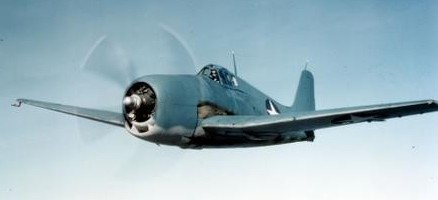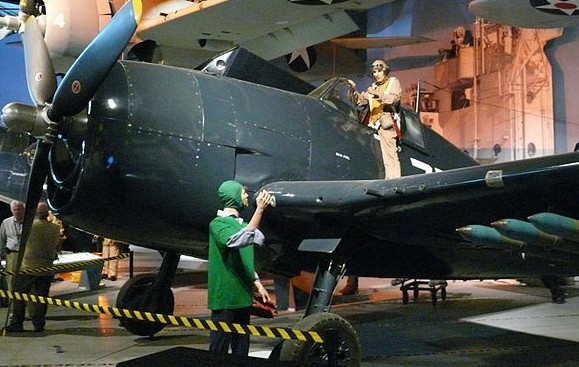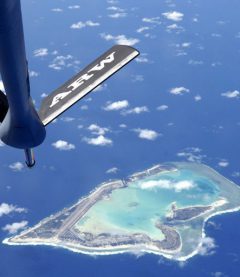
Introduction
The Grumman F6f Hellcat was a carrier based fighter aircraft of World War II. Built in the United States by the Grumman Corporation for the United States Navy to replace the aging F4F Wildcat. There was an competition within the aircraft industry that the USN (United States Navy) had to sort out.
The Vought F4U Corsair was the main competitor with the Hellcat and won out to be the primary carrier-based fighter for the USN. Then a problem arose with the Corsair in that the pilots had major troubles landing on aircraft carriers due to visibility issues on final approach.
This problem was due to the long nose of the aircraft and large 4 bladed propeller. The issue was temporarily solved as the Corsair became a land based with the USMC (United States Marine Corp) which used it to great effect against the Japanese.
The F6F had an Pratt & Whitney R-2800 Double Wasp radial engine which produced 2,000 hp. This engine was also used for the Vought F4U Corsair and the Republic P-47 Thunderbolt. While the F6F Hellcat resembled the older F4F Wildcat and was kiddingly called the “Wildcat’s older brother” it was a tough, rugged and well designed carrier fighter that was superior to the Japanese Zero.
This helped the USN have air superiority in the Pacific. There were 12,275 F4F Hellcats produced from 1943-45. The Hellcat had over 5,222 victories over enemy aircraft by USN, USMC and the British RAF pilots.

Design and Development
As early as 1938, Grumman had been working on a successor to the F4F Wildcat. Grumman came forth with the XF6F-1 prototype. The new aircraft was powered with a Wright R-2600 Twin Cyclone two-row, 14 cylinder radial engine.
The F6F had a new main landing gear hydraulically driven, wings that could be folded for storage when on board. The cockpit was raised in the fuselage for better visibility. Grumman interviewed experienced F4F pilots to gain their insight on how a great fighter should be built.
This led to further improvements in the design and features. The second Xf6F-1 prototype was outfitted with an Pratt & Whitney R-2800-10 Double Wasp 18 cylinder radial engine. Additional refinement was bullet resistance windshield, self-sealing fuel tanks, and more armor around the engine area.
The next F6F-03 prototype which became the production model flen on 03 October 1942. The first aircraft that had reached readiness came aboard the USS Essex in February 1943.
The arment consisted of 6/M2.AM Browning air-cooled machine guns in the wing. It was also fitted for an 150 gallon drop tank situated center point on the fuselage, there were bomb racks on the wings and one center point instead of the drop tank totally over 2,000 lbs.
It also had the capability of carrying 6/5 in HVAR rockets on the wings in “zero-length” launchers. The XF6F-5 with still more improvements became the most produced of all the Hellcats with 7,870 built. These included a night fighter version with special radar, although primitive today, it was the top of the line at the time.
Changes included a more powerful Pratt & Whitney R-2800 W radial engine, improvements in the control surfaces, windscreens and stronger aft fuselage. Later the XF6F-6 was built with an even more powerful engine, the Pratt and Whitney R-2800-18W two-staged supercharger radial engine with water-injection with an Hamilton Standard 4 bladed propeller with a top speed 417 mph.
This was the fastest of the F6F Hellcat models. This version was never mass produced because the war ended.

Operational History
The USN highly prefered the F6F-5 to the faster Vought F4U Corsair due to the F6F more docile handling characteristics. But it was very rugged structurally to take the rigors of carriers landings. It was also easy to maintain and could take a lot of battle damage.
After shooting down an Emily flying boat in the South Pacific as this was the Hellcats’ first victory, things heated up a bit. On 22-23 Sep 1943, Hellcats engaged in Japanese aircraft over Tarawa with 35 victories for the Hellcat and loss of only one aircraft.
Later in November 1943, a day long battle took place near Rabaul, New Britain and 50 Japanese aircraft including Zeros, were downed.
As the USN island hopped across the Pacific in the forties, a captured A6M Zero was tested and compared to the F6f. Here is the report;
“Do not dogfight with a Zero. Do not try to follow a loop or half-loop with a pull-through. When attacking, use your superior power and high speed performance to engage at the most favorable moment. To evade a Zero on your tail, roll and dive away into a high speed turn” The Zero was an superior aircraft at low speeds.
The F6F accounted for 75% of all U.S. victories in the Pacific. The USN and USMC pilots flew 66,530 sorties and claimed 5,163 victories with a recorded loss of 270 aircraft. It is admitted that sometimes victories got a little exaggerated in the course of combat.
But the best records (after the war) showed a Ratio of 13:1 over the Zero 9.5:1 over the Nakajima Ki-84 (land based equivalent of the Zero) and 4:1 over the Mitsubishi J2M. The F6F produced the most number of aces (5 victories or more) in the U.S. military during the war with 305 aces.
The USN all-time leading ace was Captain David McCampbell said “the F6F was an outstanding fighter plane. It performed well, was easy to fly and was a stable gun platform. But what I remember the most was that it was rugged and easy to maintain.”
The USN success was attributed not only to a superior aircraft but to the increasing less experienced Japanese pilots. Even at it’s best, the F6F was a superior fighter aircraft .
Where you can see the F6F Hellcat:
Airworthy
41930 F5F-3 Comanche Warbirds Houston, Texas
On Display
70222 F6F-5 Commemorative Air Force Camarillo Airport, Camarillo, California
78645 F6F-5 Yanks Air Museum Chino, California
77722 Naval Air Facility Washington at Joint Base Andrews,Maryland
79192 New England Air Museum, Windsor Locks, Connecticut
97683 Air Zoo Kalamazoo, Michigan
This is Just a Partial List of the F6F Hellcat, Check With Your Local Air Museum for More Information on the F6F
TECH SPECS for the F6F-5 Hellcat
Wingspan: 42 ft 10 in
Length: 33 ft 7 in
Height: 13 ft 1 in
Weight: 9,238 lbs (empty) 12,599 lbs (Combat Loaded) 15,415 lbs (MGTOW)
Max Speed: 330 mph
Ceiling: 37,300 ft
Range: 1,330mi (ferry)
Engine: 1/Pratt & Whitney R-2800-10W Double Wasp Twin row radial engine with a two-stage supercharger rated at 2,200 hp
Crew: 1
THANKS FOR READING! I HOPE THIS WAS INFORMATIVE!

